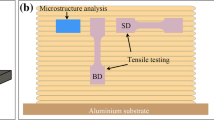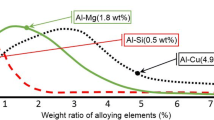Abstract
We present some consequences of Severe Plastic Deformation (SPD) of Al–Ti alloys by chip formation in machining that can enable opportunities for creating novel microstructures. Chips cut from Al-6wt%Ti are composed of a refined dispersion of the fragmented remains of a hitherto coarse Al3Ti embedded in a nanostructured matrix. This multi-phase nanostructured chip material demonstrates considerable resistance to coarsening owing to the thermally stable dispersion of ultra-fine Al3Ti dispersions and thus has promise in structural alloy applications. Furthermore, the Al–Ti machining chips are shown to possess excellent grain refining characteristics, leading to microstructurally refined and homogeneous Al alloy castings. This realization enables a low-cost route for enhancing the efficiency of the grain refiner master alloy systems by exploiting SPD during chip formation.








Similar content being viewed by others
References
Valiev RZ, Islamgaliev RK, Alexandrov IV (2000) Prog Mater Sci 45:103. doi:https://doi.org/10.1016/S0079-6425(99)00007-9
Ravi Shankar M, Chandrasekar S, King AH, Compton WD (2005) Acta Mater 53:4781. doi:https://doi.org/10.1016/j.actamat.2005.07.006
Ravi Shankar M, Verma R, Rao BC, Chandrasekar S, Compton WD, King AH et al (2007) Metallurgical Mater Trans A 38:1899. doi:https://doi.org/10.1007/s11661-007-9257-8
Ravi Shankar M, Rao BC, Chandrasekar S, Compton WD, King AH (2008) Scr Mater 58:675. doi:https://doi.org/10.1016/j.scriptamat.2007.11.040
Quested TE, Greer AL (2004) Acta Mater 52:3859. doi:https://doi.org/10.1016/j.actamat.2004.04.035
Shaw MC (1984) Metal cutting principles. Oxford University Press, Oxford
Knipling KE, Dunand DC, Seidman DN (2007) Metallurgical Mater Trans A 38:2552. doi:https://doi.org/10.1007/s11661-007-9283-6
Park K-T, Myung S-H, Shin DH, Lee CS (2004) Mater Sci Eng A 371:178. doi:https://doi.org/10.1016/j.msea.2003.11.042
Swaminathan S (2005) Nanoscale microstructures in substitutional solid solutions by large strain machining. Ph.D. Dissertation, Purdue University
Zhang Z, Hosoda S, Kim I-S, Watanabe Y (2006) Mater Sci Eng A 425:55. doi:https://doi.org/10.1016/j.msea.2006.03.018
Li YJ, Arnberg L (2003) Mater Sci Eng A 347:130. doi:https://doi.org/10.1016/S0921-5093(02)00555-5
Acknowledgements
Shankar and Cai acknowledge support from the Central Research Development Fund, University of Pittsburgh.
Author information
Authors and Affiliations
Corresponding author
Rights and permissions
About this article
Cite this article
Cai, J., Kulovits, A., Ravi Shankar, M. et al. Novel microstructures from severely deformed Al–Ti alloys created by chip formation in machining. J Mater Sci 43, 7474–7480 (2008). https://doi.org/10.1007/s10853-008-2887-4
Received:
Accepted:
Published:
Issue Date:
DOI: https://doi.org/10.1007/s10853-008-2887-4




